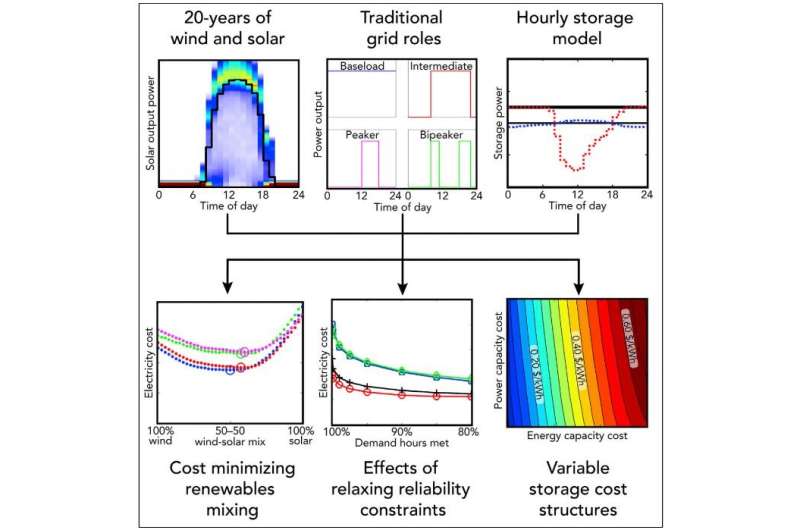How much energy storage costs must fall to reach renewable energy's full potential

The cost of energy storage will be critical in determining how much renewable energy can contribute to the decarbonization of electricity. But how far must energy storage costs fall? In a study published August 7 in the journal Joule, MIT researchers answer this question. They quantify cost targets for storage technologies to enable solar and wind energy with storage to reach competitiveness with other on-demand energy sources. They also examine what kinds of batteries and other technologies might reach these targets.
"One of the core sources of uncertainty in the debate about how much renewable energy can contribute to the deep decarbonization of electricity is the question of how much energy storage can be improved" says senior author Jessika Trancik, an associate professor of energy studies at the Massachusetts Institute of Technology. "Different assumptions about the cost of energy storage underlie significant disagreements between a number of assessments, but little was known about what costs would actually be competitive and how these costs compare to the storage technologies currently being developed. So, we decided to address this issue head on."
"Quantifying cost targets for energy storage required a new piece of insight," Trancik says, 'about how patterns of the renewable energy supply, and fluctuations in this supply, compare to electricity demand profiles. Large but infrequent solar and wind shortage events are critical in determining how much storage is needed for renewables to reliably meet demand, and it's important to understand the characteristics of these events."
In the paper, Trancik and her colleagues estimated the costs of using storage together with wind and solar energy to supply various output profiles reliably over twenty years. They then estimated cost targets for energy storage that would enable plants to reach cost-competitiveness with traditional electricity sources. They also evaluated current and future energy storage technologies against the estimated cost target.
The researchers' model optimizes storage costs by using whatever combination of storage and solar and wind gives the lowest electricity cost. This often means oversizing solar and wind capacity relative to an intended output, to decrease the amount of storage needed.
The analysis also explored the characteristics that distinguish various storage options. Some technologies are more suited to inexpensively storing large quantities of energies but outputting it slowly, at lower power, while others can cost-effectively store smaller amounts that can be quickly discharged at high power. So the model needed to capture these differences, Trancik says.
The research found that technologies with energy storage capacity costs below $20/kWh could enable cost-competitive baseload power that is available all of the time over a twenty-year period, though this target varies with the target output profile and location. They found that electricity costs respond more to costs of storage energy capacity than power capacity.
The research showed that "it's critical to reduce the costs of the materials and manufacturing that contribute to the cost of the storage energy capacity," Trancik says. "The numerical target we estimate, which varies with location, could mean a 90 percent drop in storage costs relative to today's technologies. It's a large drop but some technologies do tend to improve a lot, as we've seen in the case of solar panels, for example."
"However, and importantly, there is another factor that could raise this target considerably and allow more expensive technologies to cost-competitively store renewable energy, which is to use supplemental technologies for a small percent of the time," Trancik says. Allowing the renewable energy system to fail to meet demand for just five percent of the hours over a twenty year period can halve the cost of renewable electricity, the researchers report.
"The trick there is to figure out how to supply electricity for the remaining 5% hours. That's where we need to focus our efforts. This could potentially be accomplished with supplemental generation technologies, or perhaps demand-side management," Trancik says. Expanding the electricity transmission grid could also help mitigate renewable energy supply fluctuations, she says.
The team is exploring options for low-cost and low-carbon supplemental technologies. They are also working to model how certain research directions and economies of scale can help drive down the costs of battery technologies.
More information: Joule, Trancik et al.: "Storage requirements for shaping renewable energy toward grid decarbonization" www.cell.com/joule/fulltext/S2542-4351(19)30300-9 , DOI: 10.1016/j.joule.2019.06.012



















